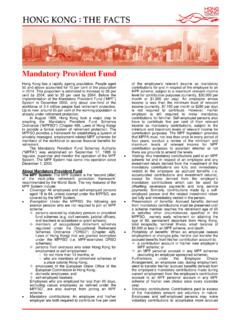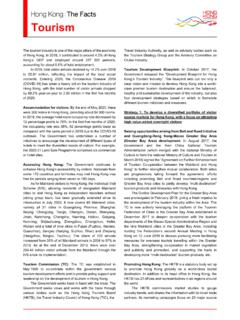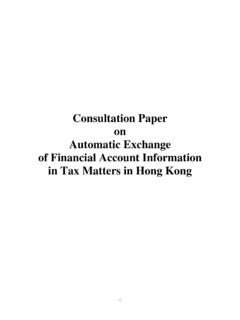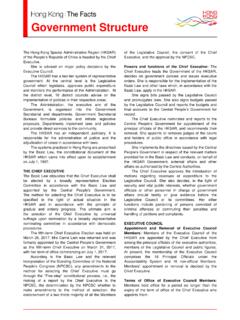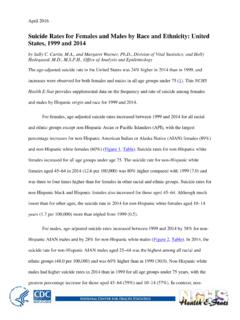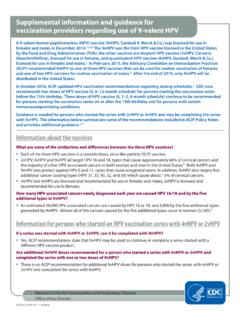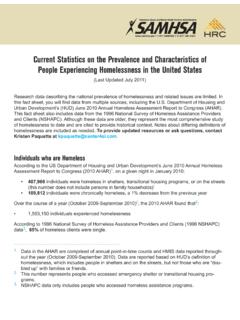Transcription of HONG KONG : THE FACTS - Gov
1 HONG KONG : THE FACTSP opulation Population Size: At mid-2014, the population of Hong Kong was million, including million Usual Residents and million Mobile Residents. During the period 2010 to 2014, the population grew at an average annual rate of Population in these years was as follows: Sex ratio Mid-year Annual rate (males per Year population of increase 1 000 females) 2010 7 024 200 883 2011 7 071 600 876 2012 7 154 600 869 2013 7 187 500 864 2014 7 241 700 858 Distribution by Area: At mid-2014, the population was distributed geographically as follows: Area % of total population Hong Kong Island Kowloon New Territories (including marine) Total ====== Population Density : Hong Kong is one of the most densely populated places in the world.
2 The land population density as at mid-2014 stood at 6 690 persons per square kilometre, and Kwun Tong, with 57 250 persons per square kilometre, was the most densely populated district among the District Council districts. Excluding marine population and area of reservoirs. Age and Sex Structure: At mid-2014, there were 858 males per 1 000 females. The median age of the total population was The age and sex structure of the population was given as follows: Male female Total Age Group Number % Number % Number % 0 14 415 200 389 200 804 400 15 24 421 400 413 800 835 200 25 34 457 200 639 800 1 097 000 35 44 466 500 673 000 1 139 500 45 54 568 500 679 600 1 248 100 55 64 519 300 532 300 1 051 600 65 and over 497 000 568 900 1 065 900 Total 3 345 100 3 896 600 7 241 700 =========== ===== =========== ===== =========== ====== Births and Deaths.
3 Fertility rate in Hong Kong has continued to remain at a low level. It has also attained a very low level of mortality by international standards. Birth and death rates are given as follows: Total Expectation Expectation Infant Crude fertility Crude of life of life mortality birth rate rate death rate at birth at birth rate (per 1 000 (per 1 000 (per 1 000 for males for females (per 1 000 Year population) women) population) (years) (years) live births) 2010 1 127 2011 1 204 2012 1
4 285 2013 1 124 2014# 1 235 Total fertility rate refers to the average number of children that would be born alive to 1 000 women during their lifetime if they were to pass through their childbearing ages 15-49 experiencing the age specific fertility rates prevailing in a given year.
5 These figures have been compiled using a population denominator which has excluded female foreign domestic helpers. The birth rate remained low ( live births per 1 000 population in 2010 to # in 2014). Moreover, according to the total fertility rate, 1 000 women in 2014 would bear, on average, 1 235# children in their lifetime as compared with 1 127 children in 2010. In 2014, the death rate was # per 1 000 population. The expectation of life at birth was # years for males and # years for females, compared against the corresponding figures of and years in 2010. There was a decline in the infant mortality rate from per 1 000 live births in 2010 to # in 2014.
6 The decline reflected a continual improvement in maternal and child health services. Education: The educational level of the population of Hong Kong has improved appreciably over the past 5 years. The following table compares the educational attainment of the population aged 15 and over++ for 2010 and 2014: % of population aged 15 and over Educational attainment 2010 2014 Primary and below Secondary** Post-secondary Total ====== ====== ** persons with educational attainment at secondary level refer to those with Secondary 1 to Secondary 7
7 Education or equivalent level. Income: The median monthly domestic household income++ for 2014 was $23,500. The distribution of domestic households in Hong Kong by monthly household income++ was as follows: % of total Monthly household income ($) domestic households Under 4,000 4,000 5,999 6,000 7,999 8,000 9,999 10,000 14,999 15,000 19.
8 999 20,000 24,999 25,000 29,999 30,000 34,999 35,000 39,999 40,000 44,999 45,000 49,999 50,000 59,999 60,000 79.
9 999 80,000 99,999 100,000 and over Total ====== Labour Force Participation Rate: The size of the total labour force in Hong Kong++ for 2014 was million. This represented of the total population aged 15 and over++. The following table shows the labour force participation rates of the population by age and sex++.
10 Age group Male (%) female (%) 15 19 20 24 25 29 30 34 35 39 40 44 45 49


